James Stewart vs. LaRocco’s Leap
By
The story behind the 2002 James Stewart photo that disappeared from the Internet.
Shawn Norfolk already had his monthly Renthal ad designed, prepped and ready to deliver to Racer X Illustrated for the October 2002 issue.
Then he logged on to MotoTalk.
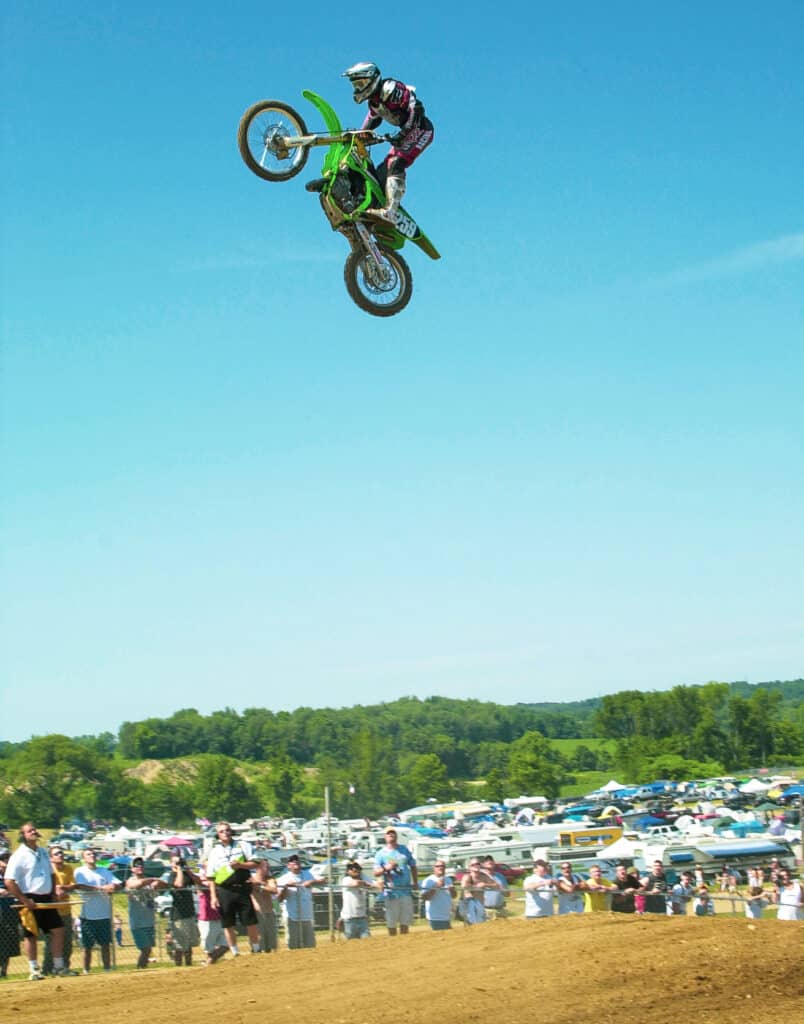
In 2002, the MotoTalk forum at MotoNews.com was THE place for race weekend info, gossip and digital photos taken by the growing band of new photo hounds trying to fit in with legends like Paul Buckley and Kinney Jones still transitioning from film cameras. To get those photos uploaded, digital photographers raced back to their hotels and prayed their in-room ethernet cables functioned. Or existed at all. And then they gave away their photos to anyone who wanted to see them.
The Brand Manager for Renthal North America, Norfolk wanted to see what happened in Saturday practice at the Red Bud AMA Pro Motocross National, three time zones to the east. He saw a thread started by “KTMKardy”.
Norfolk froze on a photo of James Stewart. He knew he wanted it before it finished loading. All 1.2 megabytes of it. Shot vertically, it had the height of a skyscraper. Azure sky made up roughly 60% of it. Hovering impossibly high over the earth, the front wheel of Stewart’s Kawasaki SR125 pointed toward 11 o’clock. The front number plate was so flat he could have balanced a sandwich on it; his head leaned so far over the front end, he could have eaten that sandwich before he landed. His feet floated above the foot pegs, yet he looked calm. Too calm for the frame stretching impact to come.
Steve Bruhn, MotoTalk’s overlord and the airline engineer-turned digital moto photo revolutionary, would have called an image like this a “modem killer”.
Put this James Stewart poster on your wall!
Who is Jeff Kardas?
Jeff Kardas had a day job and shooting photos of dirt bike racers wasn’t it. He worked in Information Technology for a big telecom firm and raced District 12 events in Northern Ohio in the 1980s and 1990s. After he stopped racing, he dabbled in photography and took his Nikon CoolPix 990 along with him to local competitions. His words and images landed in the Regional Events section of Cycle News and he uploaded selects to MotoTalk under the username “KTMKardy”. He built an online relationship with Bruhn who, it turned out, only lived a few hours away in Pittsburgh, Pennsylvania. They met up and Bruhn sold Kardas a camera body and lens, a 2.7 megapixel Nikon D1 with a 24-70mm f/2.8L.
Kardas studied camera terminology and techniques from his couch. He read manuals and tutorials to understand how to set exposure and the meaning of shutter speed and ISO and, when the Arenacross Series came to the Midwest, he leaned on Ohio riders Jeff Gibson and Willy Browning for press access.
Another door opened when Team Green News wanted Gavin Gracyk photos. A search led to Kardas, who attended the local events where Gracyk competed. Kardas became a key contributor to TGN and in 2002 he attended a handful of Pro Motocross Nationals on behalf of the quarterly that focused on Kawasaki’s Team Green program. All this coincided with the rookie season of Stewart, arguably the most high-profile and anticipated graduate in Team Green history. His job that weekend was to report on Stewart and the other young Kawasaki riders racing amateur day. When he heard chatter about the 16-year-old rookie wanting to jump LaRocco’s Leap, he lugged his gear to the west edge of the facility and found an infield spot between the second and third landings of the approximately 125-ft. triple jump.
Named after Mike LaRocco, LaRocco’s Leap is an Evel-Knievel-hold-it-wide-open-for-the-fans type of obstacle created in the early 1990s by Red Bud’s Tim Ritchie and eventual two-time Pro Motocross champion Mike LaRocco. The vertical, elevator-style takeoff obstructs the view of the landing and the deep loamy left handed sweeper before it saps engine power. The consequences of coming up short are broken spokes, wheels and hubs, occasionally bent frames, sometimes broken ankles and wrists.
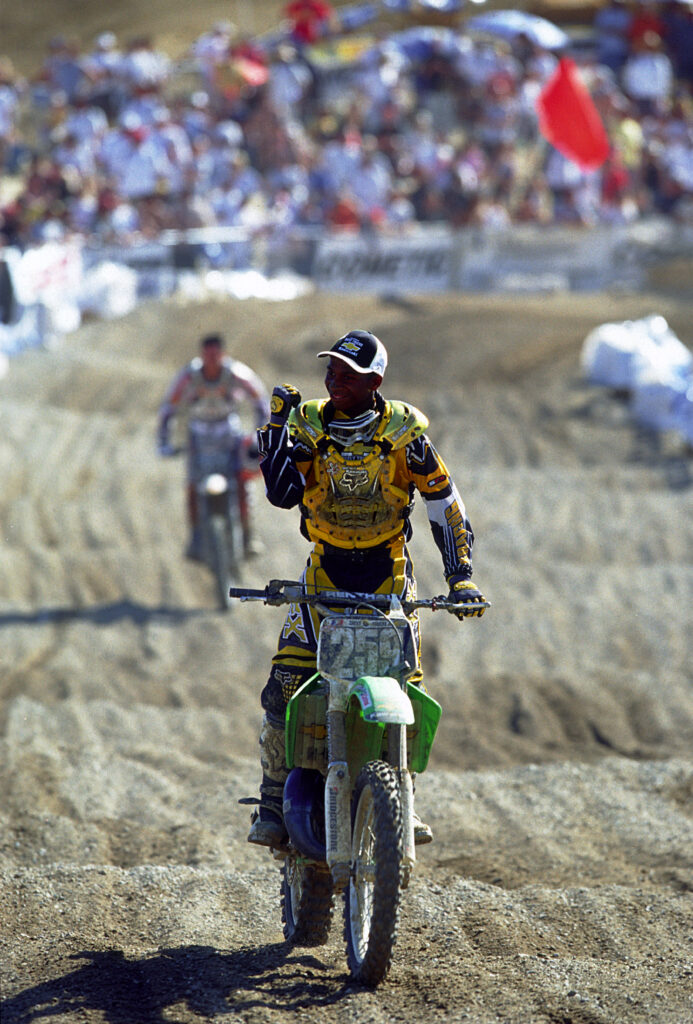
In practice, Kardas heard Stewart coming around the corner. “You could always hear Bubba long before he got there,” Kardas says. “He made 125s sound like no one else.” Kardas still thinks it weird that he turned his Nikon sideways and shot a vertical photo. He felt too new to have that kind of instinct. Had he chosen a landscape stance, the photo wouldn’t have had the same punch. The subject would appear alone against the blue background (‘guy in the sky’ as they say in video/photo jargon). There would be nothing to scale it against because the ground and people below would be cut out of the frame. With the lens zoomed to 35mm, Kardas waited for the rider to let off the throttle and he pushed the shutter.
Tick.
Tick.
Tick.
Tick.
Begging James Stewart Not To
Jeremy Albrecht changed two frames that weekend. As Stewart’s mechanic, he felt lucky they had two spares on the Kawasaki truck. They always had one. Two was abnormal. But Stewart’s ability to ride a dirt bike was abnormal. Historically, Kawasaki says it gives bikes new frames every six races, no matter what. Stewart’s steel-framed 125s got swapped every three races, sometimes after only one. Rick Asch, Kawasaki’s engine builder said Stewart’s piston, rings and reed valve petals were replaced after every single moto because the rings developed flat spots at the exhaust bridge. “He’s the only guy that I ever watched that actually scared me with how fast he was,” Asch says.
That speed was a stress test for the motorcycles and the people who built them. Stewart even broke cylinder studs. After the 2002 Southwick National (Round four) they switched from titanium cylinder studs to steel because one broke off on the starting line after the sight lap and ultimately cost them the moto win. Because of Team Green News, Kardas often hung around the Kawasaki truck and he distinctly recalls the heat that radiated off Stewart’s exhaust pipe. The metal turned shades of purple he didn’t think were possible.
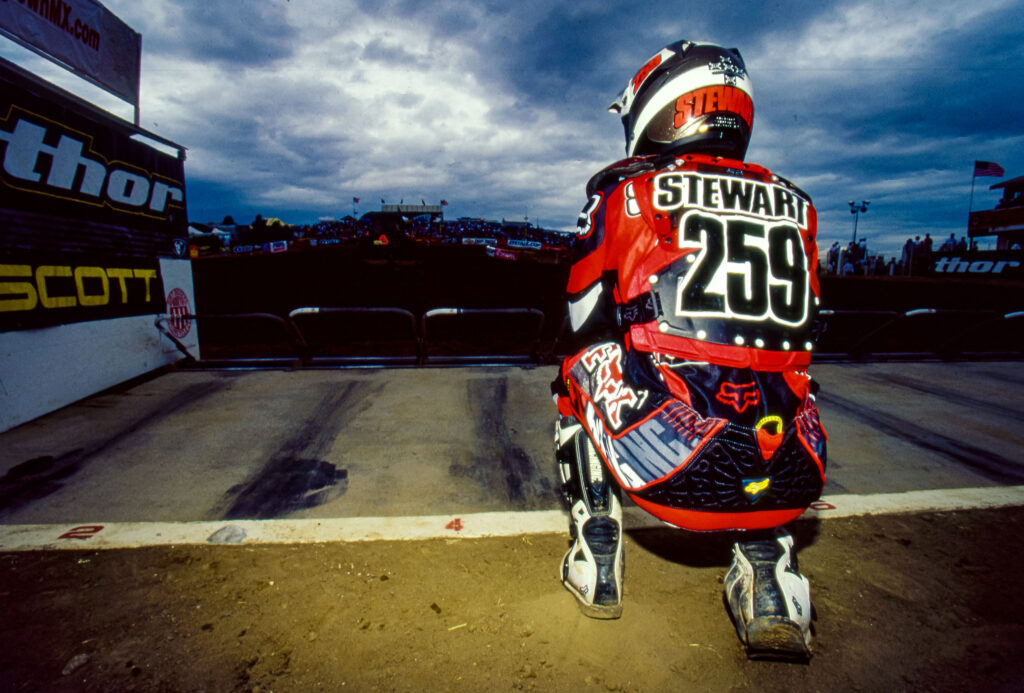
When the series arrived at Red Bud that summer, Stewart asked a lot of questions about LaRocco’s Leap. He studied recordings of races from earlier years and he wanted to know more about the jump. They told him to forget about it. “You’re going to be three to four seconds a lap faster than everyone else,” Kawasaki Team Manager, Bruce Stjernstrom says he told his young franchise rider. “You don’t need to do [LaRocco’s Leap]. His youthful exuberance got the best of him.”
He didn’t make it the first time he tried it. He clipped the top of the landing and broke a wheel and the carbon fiber headstays that connected the cylinder to the frame. Albrecht tried to put new ones on but they didn’t fit. He knew he had issues with the frame. He removed the triple clamps and pulled out a tool Kawasaki developed to measure its steel frames. The head tube was off by 12mm. Asch recalls the rear end being so far out of true that they lost one inch of wheel clearance. “He just ruined that bike,” Asch says.
Albrecht and Asch changed the frame between practices. An AMA official came over to certify and sticker it and Stewart went out and tried it again. This was the practice where Kardas got his photo. Spectator footage shows how hard Stew worked to cover the distance; he threw his upper body toward the front end of the motorcycle so hard that his head appears to pass the fender. Since his 125 wasn’t quite enough to make the monstrous leap, he created more momentum and distance from his own body.

With a stopwatch in his hand, Stjernstrom stood in front of the trackside fence and watched the whole thing. Even though he advised against jumping it, he wasn’t going to miss it.
“It was just hard to be mad at him at that time,” Stjernstrom says. “He was so good and I knew that he almost had to do it. He needed to see that he shouldn’t do it.”
After practice on Sunday morning, Asch noticed subtle stress marks in the frame. They removed the clamps and took measurements. Another bent frame. Not as bad as the first one but enough to justify replacing it. “I used to tell the team, ‘He’s going to win unless we screw it up,’” Stjernstrom says. “That day, however, I was worried that he was going to screw it up. I talked to him and his dad and said, ‘We need to stop doing this jump and just race.’”
Stewart entered Red Bud with a five point lead over Chad Reed. He went 2-1 in the motos and won the overall, extending his points lead on Reed, who finished 1-22.
Stewart didn’t jump LaRocco’s Leap the afternoon of the race.
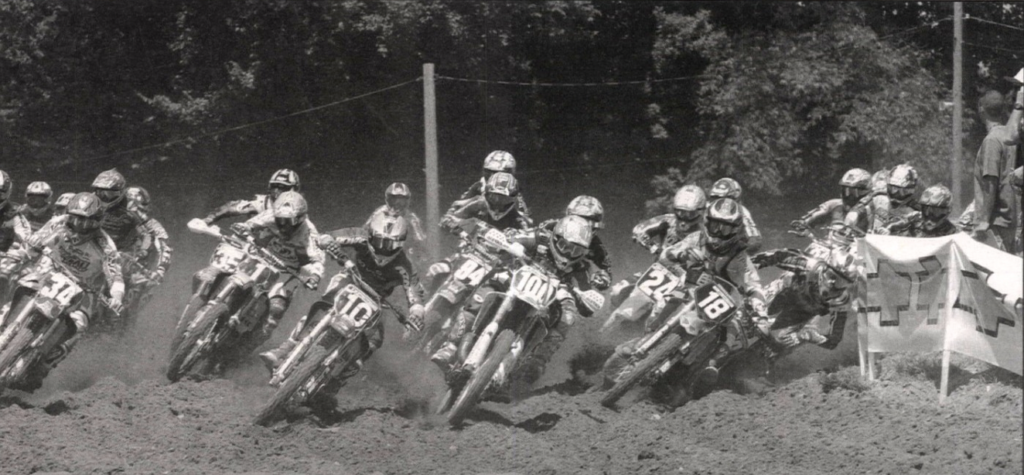
Stop The Presses!
Kardas knew he had something special. He could tell even through the mediocre quality of the Nikon’s rear display. He contacted Team Green News as soon as he could. “What should I do with this?” he asked? His editor said ‘Get it on MotoTalk’!” It instantly became an early entry into Stewart’s vast collection of OMG-impossible-to-believe pics and clips.
The photo disappeared the same evening it went up. Anyone who hadn’t yet downloaded the photo voiced their displeasure. One person called Kardas a “sellout”. Those who arrived to the thread late wanted to know what photo they were all buzzing about. Norfolk didn’t know KTMKardy but figured out how to get in contact with him. He wanted the photo for a Renthal Ad and told Kardas to name his price. Kardas said “$500.”
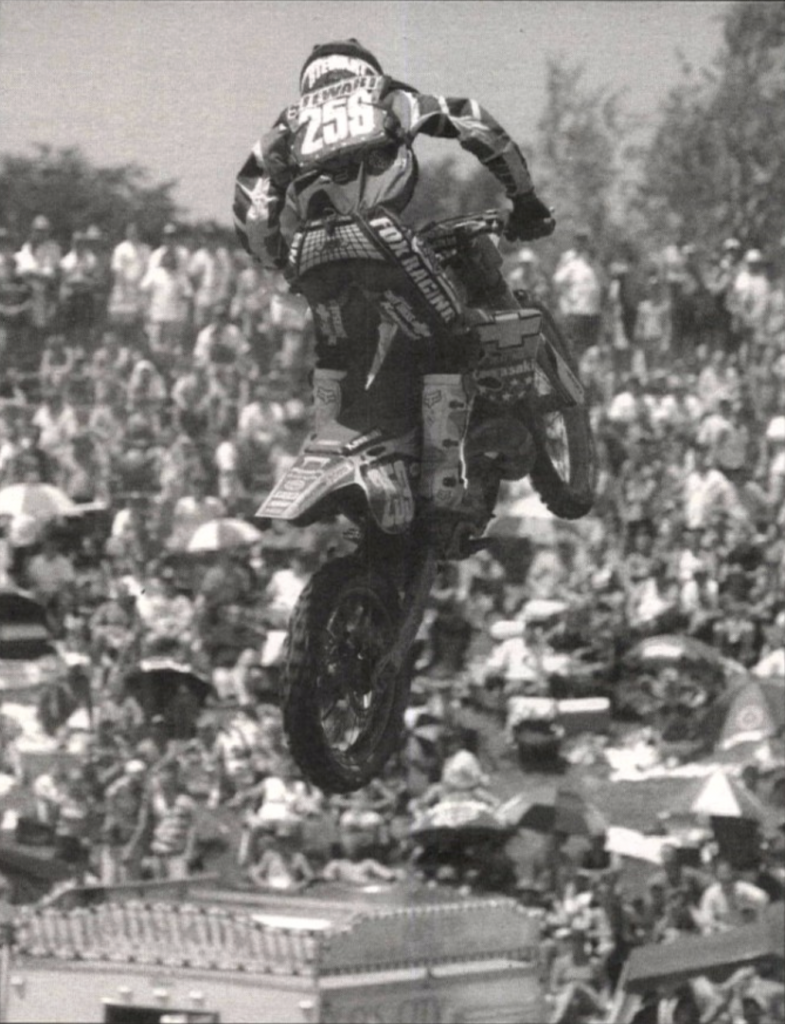
“Three hundred to $500 was normal but he could have gotten more from me,” Norfolk says. “I probably would have paid $1000. That pic was so epic.” They agreed on the price and Norfolk asked Kardas if he would remove the image from MotoTalk, which happened within two hours of the original upload.
The photo appeared on the back cover of Racer X with small copy printed next to Stewart’s back. “Yeeeeehaaaaaa!” it said in a black san-serif font. On the bottom of the page, “R&D. The fun way” was printed in white over top of the dirt. A small Renthal logo sat in the lower right hand corner. The edge of Stewart’s helmet sat about two millimeters from the edge of the page. It was one of those memorable advertisements that didn’t at all explain what was being sold but, at the same time, it didn’t matter. You couldn’t forget this image if you tried.

Norfolk even said he asked the designer to leave off the logo entirely. They mulled it over and decided their boss, the late Jim Hale, would probably roast them for that one. “Gosh, that image is so…” Norfolk says, trailing off. “I can see it in my mind and I haven’t seen it in 10 years.”
“This was the first money I made from a straight up advertisement,” Kardas says. The exposure from this one photo led to more phone calls from Norfolk. One Industries’ Ludo Boinnard (now 100%) hired him for the entire 2003 season and by the time he was laid off from his telecom job in 2004, Kardas had a legitimate side business going.
Jeff Kardas is still at the races. Follow him at @kardyphoto. And then thank him for turning that camera sideways on that sunny afternoon in July 2002.
Thanks for reading. If you value these stories, keep them coming by visiting shop.wewentfast.com. We have apparel, literature and art, such as the print below that is based on the photo described in the story!